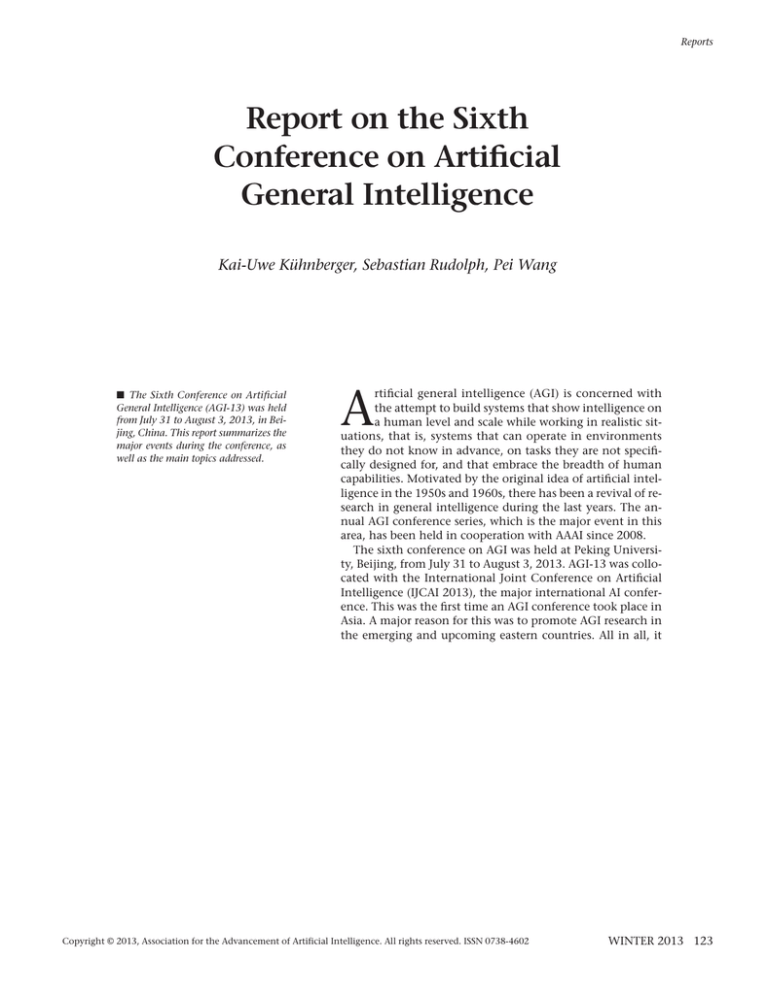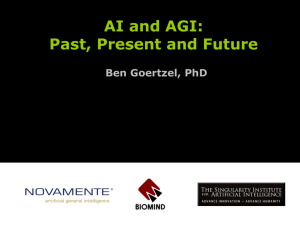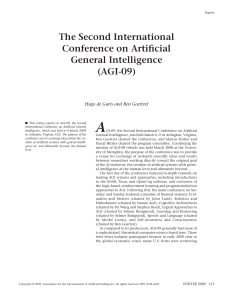
Reports
Report on the Sixth
Conference on Artificial
General Intelligence
Kai-Uwe Kühnberger, Sebastian Rudolph, Pei Wang
n The Sixth Conference on Artificial
General Intelligence (AGI-13) was held
from July 31 to August 3, 2013, in Beijing, China. This report summarizes the
major events during the conference, as
well as the main topics addressed.
rtificial general intelligence (AGI) is concerned with
the attempt to build systems that show intelligence on
a human level and scale while working in realistic situations, that is, systems that can operate in environments
they do not know in advance, on tasks they are not specifically designed for, and that embrace the breadth of human
capabilities. Motivated by the original idea of artificial intelligence in the 1950s and 1960s, there has been a revival of research in general intelligence during the last years. The annual AGI conference series, which is the major event in this
area, has been held in cooperation with AAAI since 2008.
The sixth conference on AGI was held at Peking University, Beijing, from July 31 to August 3, 2013. AGI-13 was collocated with the International Joint Conference on Artificial
Intelligence (IJCAI 2013), the major international AI conference. This was the first time an AGI conference took place in
Asia. A major reason for this was to promote AGI research in
the emerging and upcoming eastern countries. All in all, it
A
Copyright © 2013, Association for the Advancement of Artificial Intelligence. All rights reserved. ISSN 0738-4602
WINTER 2013 123
Reports
can be said that it was a great success.
The authors of the submitted papers
came from 23 different countries and
the participants of the conference were
equally international. The facilities of
Peking University provided a nice environment that promoted lively discussions. On the conference website1
interested readers can find the videos
and slides of the presentations and discussions, as well as all the papers collected in the conference proceedings.
Main Conference
Following the established tradition of
AGI conferences, all presentations
were held in a single track. Although
unusual for an AI conference, the single-track presentation has turned out
to be rather appropriate for the AGI
community, because it supports and
facilitates discussions, prompts inspirations from different fields, and allows
participants to learn more about research methodologies that are not in
the focus of one’s own history.
The presentations of the regular papers were clustered into four technical
sessions: AGI architectures and cognitive systems, learning in AGI systems,
programming and natural language
systems, and theoretical and conceptual issues of AGI systems.
AGI Architectures and
Cognitive Systems
This cluster can be called a classical
field of AGI research. Focusing on general architectures sheds light on the
implementation and instantiation of a
broad variety of cognitive abilities, the
integration aspect of different methodologies, as well as certain technical results on some of the frameworks used
for AGI applications.
Learning in AGI Systems
Rather similar to classical AI conferences in which learning abilities of systems and agents are considered to be
important, the session on learning emphasized the crucial learning aspect of
models for general intelligence. Nevertheless, the presented methods were
nonstandard in the sense that no detailed results about popular learning
methods (like Bayesian learning or kernel methods) were presented, but fresh
124
AI MAGAZINE
approaches for learning were proposed. For example, learning by combining combinatorial logic with genetic programming, learning from
experience and problem solving, or
the integration of probabilistic logic,
frequent pattern mining, and deep
learning were presented.
Programming and
Natural Language Systems
The session about languages covered
the two word senses of “language” in
AI research — first, the scientific study
of programming languages, and second, the modeling and analysis of natural language. Although this might appear to be a balancing act, because all
in all the two topics are rather different concerning their domain and the
used methods, this session turned out
to be quite inspiring. The participants
heard interesting talks about, for example, innovative approaches to natural language processing, a new programming paradigm of control
systems for robotic applications (Replicode), and Lojban++, a language that
has the potential to bridge the gap between programming languages and
natural languages.
Theoretical and Conceptual
Issues of AGI Systems
This session spanned from tractability
issues of AI and the role of (cognitively and psychologically inspired) constructions in general intelligence to
embodiment issues of AGI. Furthermore, the alignment of stochastic and
continuous real-world environments
on the one hand and discrete state
spaces and deterministic modelings (as
often required in theories for decision
making) on the other, were examined.
In this session, not only technical results were presented but also several
conceptual issues were raised.
Special Sessions
In addition to the four technical sessions sketched above, two special sessions were organized, both of them
with a strong relation to and a potentially high impact on the Asian world:
Cognitive Robotics and AGI and AGI
in Asia. Several novel approaches toward AGI were introduced and discussed.
Prizes
At the end of AGI-13 three prizes were
awarded. Two Kurzweil prizes (sponsored by KurzweilAI.Net), one for the
best paper of the conference and one
for the best AGI-related idea, have already a certain tradition in the AGI
series, as they have been awarded in
the last AGI conferences as well. The
third prize was newly sponsored by
the Cognitive Science Society. This
prize was awarded to the best student
paper.
Computational Versions of Kolmogorov Complexity Based on Cognitive Models, by C. Strannegard, A.
Nizamani, A. Sjöberg, F. Engström, was
selected as the winner of the Kurzweil
Best AGI Paper. Resource-Bounded Machines Are Motivated to Be Effective,
Efficient, and Curious, by B. Steunebrink, J. Koutník, K. Thórisson, E. Nivel, and J. Schmidhuber, was selected as
the winnter of the Kurzweil Best AGI
Idea Paper. Where Almost Is Not Even
Close: Remarks on the Approximability of HDTP, by T. Besold and R. Robere,
was selected as the winner of the Best
AGI Student Paper.
Keynotes
As is commonplace for international
conferences, important highlights
were the keynote talks. At AGI-13, Stuart Shapiro (professor emeritus of the
University of Buffalo), Thomas G. Dietterich (University of Oregon), and
Dileep George (Vicarious Systems, Inc.)
gave inspiring talks about their view of
artificial general intelligence.
Stuart Shapiro presented in his
keynote a Modal Grounded Layered
Architecture with Integrated Reasoning, which can be considered as a typical AGI project, given the cognitive
functions involved. This architecture
was exemplified using various agents
ranging from Wumpus World Agents
to cleaning robots and delivery agents.
Furthermore, Shapiro presented details
of the architecture itself: for example,
he explained the perceptuo-motor layer, the knowledge representation system SNePS 2.8, and the supported reasoning mechanisms. In total, the talk
showed a general framework that can
be instantiated for various application
domains in order to show general
forms of intelligence.
Reports
Thomas G. Dietterich, presidentelect of AAAI, presented details about
CALO (cognitive assistant that learns
and organizes), a multi-institutional
cooperation on an electronic secretary.
The important aspect in this project
that is targeted at general intelligence
is the integration of many abilities:
CALO is able to support the user in
tasks like email management, scheduling, summarizing meetings, project
management, presentations, and
many more tasks that appear quite regularly in administrative types of work
of many institutions. In order to enable the system to do that, CALO integrates many classical challenges of AI
research like rudimentary natural language processing abilities, learning
mechanisms (such as for profiling
users), new interface design types for
intuitive usability, appropriate knowledge representation formalisms, handling of uncertainty, and many more.
Beside the design of CALO, the talk also summarized the lessons learned
from its building.
Dileep George suggested building
AGI “the brain way.” He explained the
neuroscientific foundation of several
cognitive functions, as well as the way
to model them in computer systems.
He suggested that the mechanism
found in neocortex is both general and
efficient, and it is based on hierarchical structure. It is argued that a brainlike system should be built starting
from perception and action rather
than from high-level cognitive function like reasoning or planning.
Workshops and Tutorials
Following the tradition of AGI conferences the framing days of the main
conference were dedicated to workshops (July 31) and tutorials (August
3). Another tradition of AGI conferences is that workshops and tutorials
are not held in parallel sessions but, in
a manner similar to the main conference, are organized in a single-track
structure. This ensures a large number
of participants in the workshops and
tutorials and is a pleasant contrast to
sometimes rather sparsely populated
workshops at large AI conferences.
The two workshops that were offered at AGI-13 were Formal Magic:
Formalizing Mechanisms for Artificial
General Intelligence and Cognition,
and Probability Theory or Not? Practical and Theoretical Concerns on Uncertainty Handling in AGI. Both workshops addressed important challenges
of AGI research, namely the formally
sound foundation of any AGI-relevant
approach and an assessment of the
currently popular probabilistic direction of AI and AGI research. Both challenges are important: if it is true that it
is time to develop a new research paradigm for AGI, then a thorough formal
basis is necessary for progress. Concerning the second workshop, it is important to raise the question to which
extent the current popularity of probability-based methods in AI research
could also be a reasonable choice for
AGI research. The papers presented at
the two workshops contributed important aspects to the main discussions in
the sketched fields of challenges. Additionally, the organizers augmented the
workshops with invited lectures that
triggered fruitful discussions that may
affect future AGI research.
The tutorials were taught by Stuart
Shapiro and Marcus Hutter. Shapiro explained his MGLAIR architecture more
thoroughly, and Hutter reported his
perspective on a decade of universal artificial intelligence with the AIXI model and its extensions. The tutorials
highlighted directions of AGI research,
namely the reinforcement learning approach enriched with insights from
Kolmogorov complexity, data compression, and information theory on
the one side and the extensive work on
cognitive architectures and cognitive
systems on the other.
Note
1. See www.agi-conference.org/2013.
Kai-Uwe Kühnberger is a university professor and dean of the faculty of human sciences at the Institute of Cognitive Science
of the University of Osnabrück. He received
his Ph.D. in computational linguistics from
the University of Tübingen in 2002. His
main research areas are nonclassical reasoning, ontologies, and text technology, computational creativity, and cognitively inspired learning mechanisms. He is
editor-in-chief of the Springer series Thinking Machines and survey editor of Cognitive
Systems Research. He was a program committee cochair of AGI-13.
Sebastian Rudolph is university professor
for computational logic at the AI Institute
of the Technische Universität Dresden. He
received his Ph.D. in mathematics from
that university in 2006. His main research
focuses are the modeling and reasoning aspects of logic-based knowledge representation, ranging from the mathematical and
formal foundations of diverse knowledge
representation paradigms to their applications to areas like the semantic web. He
serves on the editorial boards of the Journal
of Web Semantics and the Journal on Data Semantics and on the steering committees of
several AI-related conferences. He was a program committee cochair of AGI-13.
Pei Wang is an associate professor at Temple University. He received his B.S. degree
and M.S. degree in computer science from
Peking University, in 1983 and 1986, respectively, and his Ph.D. degree in computer science and cognitive science from Indiana University, Bloomington, in 1995. His
research focuses on unified theories of intelligence, formal models of rationality, reasoning under uncertainty, learning and
adaptation, and real-time decision making.
He was the conference chair of AGI-13.
Conclusion
The Sixth Conference of Artificial General Intelligence was a well-organized,
successful conference that took place
in the center of the emerging Asian scientific hightech culture. The conference included many inspiring presentations that, we hope, will encourage
future researchers in Asia to participate
in and contribute to this line of research. The emerging Asian research
community can make a difference in
developing AGI in the future.
WINTER 2013 125






